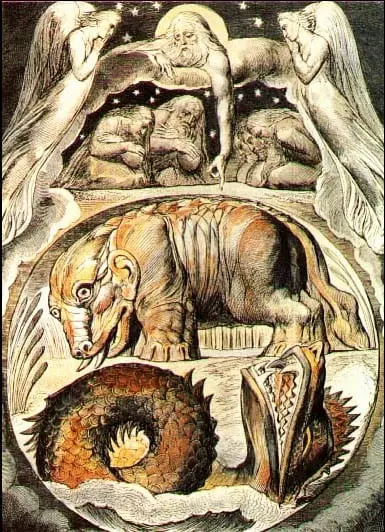Have you ever wondered just what kind of animal the “behemoth” mentioned in Job actually is- or if it ever even existed? If so, you’re not alone.
Logically, there are only three possible conclusions:
- Behemoth is mythological.
- Behemoth is a real animal existing somewhere on earth today.
- Behemoth was some type of real, but now extinct animal.
In Part 1 of this series we’ll consider the first option.
Could Behemoth be mythological?

Many liberal scholars ascribe to this view which revolves around the belief that the Bible “borrows” from pagan mythology for the purpose of “illustrating” and “communicating” truths. A variation of this view argues that while the writers of Scripture didn’t “believe” pagan mythology, they did utilize imagery from these myths. Both groups point to similar creatures described in mythology to bolster their arguments. This view is attractive to some scholars simply because the modern candidates for option number 2 obviously do not fit the textual description of behemoth.
There are three refutations of this view which I find particularly compelling:
1. Scripture refers to Behemoth as a real animal:

Job 40:15 states that Job and behemoth are equally God’s creatures:
“Behold now, Behemoth, which I made as well as thee”.
Essentially God says, “Look at behemoth. I made it just as I made you.” Pretty straightforward. He is comparing His creation of the creature called behemoth to His creation of the literal, historical person named Job. There isn’t any implication in the text that behemoth is mythological or symbolic.
In his article for Apologetics Press, Eric Lyons notes that every time “behemoth” is mentioned outside of Job 40 it refers to a real animal. When the Lord first speaks, in Job 39, He describes real animals in order for us to understand important truths about the nature of the world. He refers to mountain goats, donkeys, oxen, ostriches, horses, and hawks. It really doesn’t make sense that God would be describing all these real animals then suddenly switch to mythological ones.
Wayne Jackson writing for Christian Courier explains that the English word “behemoth” is a plural form of the Hebrew “behema,” which is found 9 times in the Old Testament. It’s basically a generic word for “beast.” However, the plural form in which it is used in Hebrew is regarded as a device to “intensify.” For example, “great beast”, “super beast,” or “the noblest and strongest beast.” God considers behemoth to be a masterpiece of His creation.
Admittedly, Job is a highly poetic book in which hyperbole abounds. However, the use of this literary device can’t be employed as an argument to negate the reality of the animals it is used to describe due to the fact that it is used in earlier poems to describe literally existing animals. Lyons adds that although hyperbole is used in the description of certain elements of behemoth (bones made of metal, etc), this is simply consistent with the poetic nature of the book of Job. Lyons writes:
“Allowing for the use of highly poetic language at times, the book of Job remains realistic throughout. Job was a real person (Ezekiel 14:14,20, James 5:11) who experienced real pain. He challenged a real God that was (and is) alive. Jehovah described real creatures in Job 38 and 39. So there is no legitimate reason for rejecting behemoth and leviathon as real animals.”
2. The Biblical description of Behemoth is a far cry from its assumed pagan counterparts:
Lyons counters the claim that behemoth closely resembles beasts from pagan mythology by noting that there is nothing called “behemoth” or anything similar in pagan mythology. He cites Marvin Pope’s (professor and authority on ancient Ugarit) comparison of behemoth to “the ferocious Bullock of El” slain by the goddess Anat (Baal’s sister) from ancient Ugarit texts. Lyons objects to this inconsistency since behemoth is not described as fierce or predatory, but rather a herbivore who grazes among other animals, lies in the water, leisurely drinking from the river. This may seem a minor departure from mythology, but it is actually quite significant. Mythology depicts ferocious beasts that the gods must overcome in order to establish their superiority. The polar opposite is true in Scripture. John Hartley notes in his commentary on Job:
“In contrast to mythological thought, Yahweh did not have to defeat Behemoth to gain control over the forces of chaos. Rather Behemoth obeyed him from the first moment of origin.”
3. Finally, the mythological view does not make sense within the context of the lesson that Job is learning:
Job’s account of undeserved suffering addresses the age old question, “Why do bad things happen to good people?” He goes back and forth in poetic dialogue with three friends. Finally, God interrupts and “takes Job to court” demanding that Job answer several questions. The questions are rhetorical with the intent of demonstrating to Job how little he actually knows about creation or the power of God.
It is in this context that God mentions His creation, behemoth. God goes into detailed description of some of His creations highlighting particularly the glory of two gigantic beasts- behemoth and leviathan. The entire point of God’s line of questioning is to demonstrate His unlimited power and to make Job aware of the limitations of his human knowledge. Consider this scenario:
God says, “Look at all these incredible animals with all of their awesome characteristics that I have created Job.” Then, He lists two animals that are fantastical concoctions of pagan mythology.
What would Job’s response be? Lyons hypothesizes the following, “Lord, what’s your point? These creatures are mythological!” He then concludes, “God’s argument would have collapsed of its own weight.”
Conclusion
No better conclusion can be stated than Lyons’ citation of Robert Gordis’ commentary on Job calling for scholarly adherence to proper exegesis:
“Scholars who take the mythological approach when interpreting Job 40-41 simply are making comparisons to their liking. They have been so captivated by ‘apparent’ parallels in ancient literature that they have lost sight of the basic exegetical test—the relevance and appropriateness of the interpretation within the context of the book of Job.”
With the mythological option logically discarded, in Part 2 we’ll examine the remaining alternatives for the identification of behemoth.








when i was a young boy i was afraid of dinosaurs but being older i am afraid no more